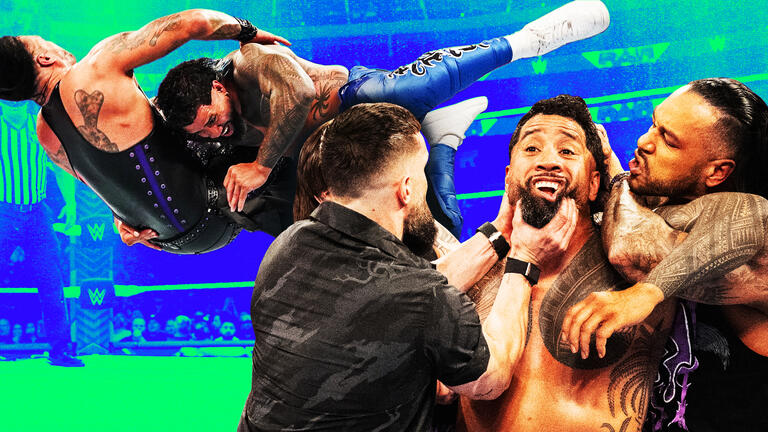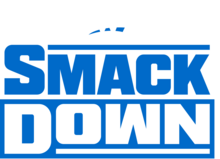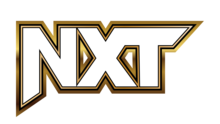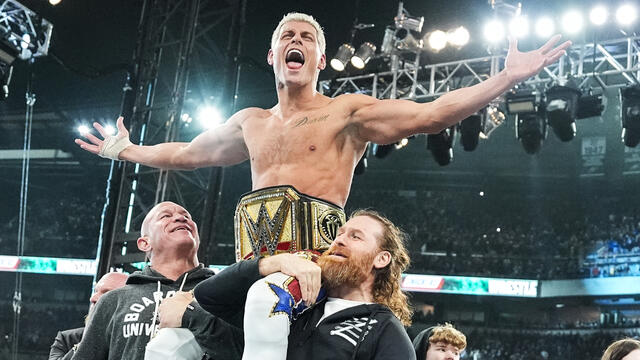
'No heroes here': Three days at a WWE tryout
The strength and conditioning gym inside WWE’s Performance Center in Orlando, Florida, was alive on a Friday morning in early September.
A mix of classic rock, from Janis to Skynyrd, blared out of speakers as more than two dozen men fought fatigue while in the midst of grueling circuit training. Every 45 seconds or so, a whistle blew, signaling time for the men to shift from one station to the next. Like an engine lurching into gear, one group of recruits moved from pushing weighted sleds to performing burpees, while another transitioned from box jumps to squats.
Watch this must-see video recap of the September tryout | View photos
This was Day 2 of what were, for most of the men there, the three most important days of their professional lives. It was a WWE tryout, one of the very first steps the Superstars of tomorrow must take in their long and arduous journeys to becoming the next John Cena or Randy Orton.
Normally, such tryouts are closed-doors affairs involving only the invitees, the Performance Center’s coaching staff and select WWE personnel. This camp was an exception. Not only was there a reporter from “Muscle & Fitness” embedded in the pack, but there were also cameramen and photographers from WWE.com, who tagged along to document this all-important process.
Read "Learning the Ropes" in the November issue of "Muscle & Fitness"
At 9:36 a.m., trash cans were brought in and placed strategically around the room, receptacles for the bile that inevitably spewed. Vomit is almost a foregone conclusion on Day 2. That’s why they call it “the meat grinder.”
‘Under the microscope’
A day earlier, just after finishing their early-morning medicals, the camp gathered around the center ring for their orientation. The recruits stood quietly as head coach Bill DeMott, the man charged with leading the tryout, welcomed them.
“This is our house,” he told the camp, “and for the next three days, it’s your house, too.”
DeMott proceeded to lay down the house rules as the guests listened intently. There was Jeff Cobb, a stout Olympic wrestler who represented Guam in the 2004 Summer Games. A fresh-faced, tire-flipping strongman named Michael Fierro gazed on wide-eyed, as did Justin Whitley, a kind-looking bodybuilder who spends his days in uniform as a prison security guard. Richard Swann, a 5-foot-8 high-flyer who’s a known commodity in independent wrestling circles, stood toward the back.
“Wipe your feet before entering the ring,” DeMott instructed, while his lieutenants Robbie Brookside, Norman Smiley and Jason Albert silently assessed the platoon. WWE Hall of Famer Gerald Brisco was there, too, on hand to offer his universally respected input.
“Leave the Performance Center in the condition you found it,” DeMott continued. Indeed, every day ended with the men mopping the floors and cleaning the rings and mats. “Be on time,” he said. The Performance Center adheres by the “if you’re not early, you’re late” doctrine.
“Remember, this is a tryout camp, not a training camp,” DeMott said.
The address was familiar to some. Jason Shirley, a massive former NFL defensive tackle, was back for his second tryout, having sat out much of his first due to injury. Also returning was Kenneth Allen Crawford, a U.S. Marine Corps veteran with a stellar track-and-field background. He’d put on about 40 pounds of muscle since his first visit a year earlier.
15 gridiron greats in WWE history | 10 Superstars who served in the U.S. military
Despite the camp’s impressive athletic composition, the pervading vibe inside the Performance Center was anything but one of confidence on Day 1.
“Just having the opportunity to come here for a tryout with the No. 1 sports-entertainment company in the world is a lot of pressure,” Smiley explained inside a conference room, before the drills commenced. “You’ll see guys walk around who maybe outside this building are more outgoing, but here, they know they’re under the microscope. They look around the room, knowing certain guys are world-class athletes, MMA fighters. It’s extremely intimidating."
'Pull your socks up!'
With the formalities out of the way, the camp slowly embarked on its first sets of drills. Digg Rawlis, Hugo Knox and James Jensen — three of the Performance Center’s high-level beginners and the recruits’ “measuring stick,” according to DeMott — led a series of stretches and calisthenics. Blayne Beale-McDonald, a 6-foot-6 carrot-top grappler from Northern Iowa University, used a neck bridge as an early opportunity to display his Division I wrestling pedigree. “Look at him showing off,” one trainer joked to another.
After the jumping jacks and pushups and Hindu squats, the recruits were shown the basic, yet fundamental techniques that would set the tone for everything to follow. The most impossible thing about wrestling is that the most basic ring movement nuances don’t always quite look as difficult as they truly are. Even standing upright from a supine position carries specific instructions.
10 things you didn't know about the WWE Performance Center
Recruits called out their last names as they entered the ring one-by-one to perform the relatively tame Hamburg rolls. The camp was split almost evenly between independent wrestlers and athletic newcomers, and upon the first drills inside the ring, it immediately became clear who fell into which category. The slightest introduction of legitimate pro wrestling instantly erased every athletic instinct these men had.
“Speed kills,” DeMott advised, as a look of shock overtook the faces of some first-timers, their equilibrium and coordination being put to the test.
Soon, Brookside introduced his namesake drill, the Brookside Shuffle. The three Performance Center trainees demonstrated first, putting their hands behind their heads and shuffling laterally along the perimeter of the ring, switching directions upon cue. Then, four at a time, the recruits entered the ring to do the same. Ideally, each prospect shuffled in sync with his partner across the ring. Brookside preached “minimalistic feet.”
Six-packs and white teeth are nice, but breathing, footwork, timing — these are the things that matter at the Performance Center. Convinced he can learn everything he needs to know about a wrestler by watching his feet, Brisco now spends the first day of all tryouts examining prospects exclusively from the knees down. The shuffle is a telltale footwork drill.
By the time the Baldo bag — an endurance-testing drill that simulates the in-ring act of running ropes, dropping down, and jumping back up and over grounded opponents — came about, enthusiasm had turned to exhaustion. The athletes had to nail the exact sequence, which was tough enough, never mind the actual mechanics involved. Suddenly, hitting the ropes — the kind of thing that is so basic it routinely goes unnoticed — became an awkward spectacle.
The drills eventually grew to consume three rings, with a line of bruisers and blue-chippers snaking through the Performance Center, going from one ring to another to perform shuffles, leap over bags and do tiring knee raises in the corner, dubbed “grape squishers.” Sione Finau, a former D-I linebacker and MMA fighter who was referred to sports-entertainment by Batista, let out a warrior’s shriek. “That’s it,” Brookside encouraged.
Having to circulate through multiple rings, however, was a challenge, even to the lightest and most accomplished independent wrestler there. As Swann stepped into the last ring for a final set with the Baldo bag, Albert playfully asked the recruit how heavy his legs felt.
View up-close photos of WWE's September talent tryout
Slowly but surely, men of stone turned into pats of butter. A jacked but dehydrated bodybuilder was told to see the physical therapist for electrolytes. Cramps set in. Some recruits began flailing and tripping over their own feet, despite constant reminders to breathe and take their time. There was a balance between hurrying and taking it slow that only the top prospects could handle. These exercises are capable of making world-class athletes look like grizzly bears on roller skates.
“It’s only the first session of the day and I see a bunch of miserable young men right now,” DeMott stated.
During a set of Brookside shuffles, one group of four almost fell apart completely, turning into a collection of pinballs instead of an in-sync team. Brookside couldn’t help but let out his frustration. “Everyone knows what composure is,” he belted out across the room. “I don’t see any composure. Pull your socks up!”
‘Somebody show me something!’
Midday, the camp broke for lunch, which was also the coaches’ first chance to share their early impressions with each other. While flipping through their dossiers and comparing notes, several coaches — struggling to identify which guy on the floor matched the photo on the résumé of the yoked dude with tree-trunk quads — petitioned for a new rule: The photos on the résumés must be recent. Also a consensus point: No more selfies.
DeMott, meanwhile, looked ahead to the afternoon, when the coaches would begin to get a true sense of the personnel they’re working with. “The second session is always very telling,” he said. “This is when you start to get your guys who you’re going to want to spend your time with now. Always. The first day is the one where you find out who you’re dealing with for the next two.”
The afternoon unfolded much like the morning. First, the group reassembled for warm-ups. DeMott kept things light, chastising Swann over moving positions on the floor and messing up his “feng shui.” With a smile, he told the youngster to move back to where he was originally.
WWE's 20 most impressive physiques ever | The indie influence on WWE
At DeMott’s camp, nothing seemed to be held in higher regard than a prospect’s ability to be coached. It’s a quality that can manifest itself in any number of ways. In some instances, it’s an indie darling putting his deserved ego on the shelf. Elsewhere, DeMott asked two giants to sit down in short order after the men had clumsily powered through drills they learned hours earlier. The head coach told them not to read too much into it.
“It’s OK to be a little tired,” DeMott said. “There are no heroes here. No one gets banged up. No one gets injured here.”
As the sets of Brookside shuffles and Baldo bags wore on, however, it became obvious the first appreciable break of the tryout did not result in an uptick in energy or improved poise. If anything, some recruits appeared more sluggish, more anxious.
“Somebody show me something!” DeMott pleaded. “If I’ve already got 70 of the most elite talent [in NXT], then what are you doing here? Challenge me for the next three days to give you more. Challenge these coaches to evaluate you on more than how you walked in or the picture you sent us on a damn résumé. I want you to realize what this is: It’s an opportunity to come here and get an opportunity.”
DeMott then ordered Rawlis, Knox and Jensen to speak to the group inside the weight room, away from the coaching staff. The prospects took a knee as the Performance Center trainees — who earned developmental contracts at tryouts just like this one — tried lighting a fire under them and reminded them why they’re here.
Go inside the WWE recruitment process with this must-watch video
Spurred on, the camp roared out of the pep talk, visibly reinvigorated, and before long, a new trend developed: Whenever a drill reached its final set in the third ring, the rest of the camp gathered around to cheer on their peers.
With Day 1 almost in the books, DeMott ended the second session the same way he’d close each day, by thanking the camp for their efforts and acknowledging the hard work they put in. The show of respect was not to be confused with blanket approval or satisfaction.
“When you step in my ring, act like you want to be here,” he reminded the men before tasking them with what would become a nightly ritual of cleaning the facility. As former Olympians and professional athletes tied up trash bags and disinfected the ring canvas, the sense that there was much, much more still to be accomplished hung heavy in the air.
‘I need all the helmets’
The rigorous circuit training that kick-started Day 2 went a long way in evaporating the jitteriness that defined Day 1. Still, the coaches found ample opportunity to motivate the prospects as everyone geared up for the new and more complicated drills that lay ahead.
“I’m not passing the guard to someone who doesn’t deserve it,” Albert told the group in-between drills on Day 2, “and I’m real tight on who I think deserves it. You should look at yourself in the mirror at the end of the day and say, ‘I’ve left it all out there. I’m proud of what I’ve done.’ Because living life with ‘What ifs?’ sucks. Never regret what you did. Always regret what you didn’t do.”
Nonetheless, several broad-shouldered competitors, exhausted by the a.m. workout, fell from the pack and took seats. Crawford, the marine pegged by several coaches as an early standout, tweaked his knee and was tended to by the trainer; he vowed to return to the ring by the second session.
View photos of the "Muscle & Fitness" embedded editor's experience
Moments later, while four heavyweights performed a rope-running drill, a scary scene transpired as the top rope broke. The sage Brookside, knowing the potential dangers of the situation, shook his head in relief.
“That’s a frightening experience,” he said, crossing from one ring to the next. If the rope snapped in the middle rather than the corner, as it had, it could have been much worse. “Your only hope then is to pray to your maker,” Brookside said.
Without missing a beat, WWE official Shawn Bennett led four men who were there trying out to become referees into action to replace the broken strand, while the recruits who were in the ring when the rope broke charged into another ring to finish the drill. They showed no trepidation; instead, they seemed proud, as if the severed rope was just further evidence of their hard work.
Though energy levels were high, that didn’t mean the camp was fully heeding instructions. A new and more intricate rope-running drill resulted in more than a couple of stumbles. After two consecutive mess-ups, DeMott moved Swann and his ring partner to the back of the line. It wasn’t the only time the head coach took an interest in the camp’s most accomplished indie wrestler. He later took the 22-year-old to task for being the last man back from a water break.
By early afternoon, DeMott called for head gear — “I need all the helmets,” he commanded — meaning the camp was ready to undertake its first sets of falls. There’s never a guarantee of safety in sports-entertainment, but knowing the best way to land when somebody else slams you or clotheslines you against your will, and committing that knowledge to muscle memory, can go a long way in extending Superstars’ careers. Though it’s practically second nature to the men with wrestling experience, the falls were brand-new for much of the camp. Either way, everyone was ordered to strap on head gear and wear it until they proved they could fall without injuring themselves.
One by one, the men cycled into the ring. By the second round of falls, most of the independent wrestlers had their helmets off. Over time, twists and turns and flips were added to the equation. When Crawford, back from his knee strain, nailed one of the more difficult falls, he celebrated in style, landing a picture-perfect backflip mid-ring. The camp exploded with enthusiasm and support, and the combination of camaraderie and competition that was taking shape on Day 1 suddenly amplified, seemingly energizing the prospects for the remainder of Day 2.
Take a video tour of the WWE Performance Center
No longer did the camp wait for drills to reach the final ring before cheering their peers on. For one set of Brookside shuffles, the chants and applause started right out the gate. Each time Brookside blew his whistle, the recruits standing outside the ring shouted “Shift,” indicating a change in direction inside the ring. The chants became more frequent and more unified, and the drills crisper. Observing 20 feet away on a nearby ramp, DeMott let a grin spread across his face.
“Now we’re a camp!” he shouted. “Sometimes it’s not how you start, it’s how you finish, right?”
“Yes, sir!” the recruits replied. The prospects weren’t asked to clean up the ring area as Day 2 ended. Instead, they raced to find the vacuums and disinfectant spray without prompting. Beale-McDonald, the collegiate grappler, wore a focused look on his face as he was the first to grab a mop.
Welcome to the ‘red-light district’
A different kind of nervous energy filled the Performance Center on Day 3. Several alpha males paced the floor inside the strength and conditioning gym, their eyes darting to rows of chairs lined up in the ring room, which was now dimly lit. The squad was fashioned in a variety of outfits: Some dressed in their ring gear and some in button-up shirts and slacks, while others opted for more elaborate getups involving props like a whip and a torch.
While there would be time to practice more rolls later on, the top priority on the agenda was what the coaches called promo class.
Wrestling interviews 101. Public speaking. By any name, the first session of Day 3 is every bit as telling and valuable to those evaluating talent as the countless rolls and shuffles performed on days one and two.
Joining the coaching staff were WWE Hall of Famer Dusty Rhodes and “The Witchfinder General” William Regal, two of the ring’s all-time greatest orators, as well as proven judges of talent. Brookside bestowed the “Witchfinder” moniker upon his friend and fellow Brit for good reason: “William Regal can sniff talent out at a yard’s pace,” he had warned the recruits a day earlier.
“No personality? Can’t entertain? What good are ya?” Rhodes asked the rapt men.
“How is this here fat a** gonna draw money?” The American Dream continued, referring to himself. Then, he pointed to the camera, or the “red-light district” as he called it, before explaining the answer: “Communicating with the audience.”
The objective of the workshop was to deliver a minute-long interview. Regal discouraged the prospects from delivering stereotypical wrestler rants — the barking and finger-wagging that once dominated sports-entertainment trash-talk. Think subtlety, he said, and don’t forget the importance of facial expressions. He cited Randy Orton’s precisely timed teeth-clench, that little ripple on The Viper’s jawline during moments of simmering intensity, as such an attention to detail.
The first several interviews, save Beale-McDonald’s weightlifting preacher routine, turned out rigid and awkward. Camera shyness clearly played a major role. Thomas Kingdon, a hard-working but soft-spoken bodybuilder who thrived in the physical drills, gave a stilted interview, only to loosen up the second coaches eased him into conversation.
“To be a great communicator, you have to be vulnerable,” Regal professed.
The performances improved steadily. Shirley, the 350-pound ex-football player, humorously described the looks he gets when he walks his two 25-pound French bulldogs. Levis Valenzuela Jr., a fedora-wearing, Spanish-speaking bolt of charisma from the Mid-Atlantic area, improbably flew under the radar for the first two days by just keeping his head down and heeding the coaches’ words. He floored everyone once he got in front of the camera.
WWE's top 25 masters of the mic | Sports-entertainment's 15 most baffling interviews
Wearing a lava-lava, the traditional garb worn in Polynesian cultures, “The Mad Tongan” Sione Finau shouted in a way that was familiar but compelling. When his time was up, he delved into his personal life, revealing he was once scheduled to be Batista’s opponent in an MMA fight and that “Tongans love Hometown Buffet.”
For his on-camera, Swann carried an acoustic guitar and effortlessly bounced between speaking Japanese and beatboxing.
“I like your jacket,” Smiley told Swann afterward. The upstart was sporting a black Ribera Steakhouse ring jacket featuring the longhorn insignia of the famous Tokyo restaurant. Obtaining the jacket is something of a sports-entertainment rite of passage.
“That’s because you have 72 of them,” DeMott shot back at Smiley.
Once the interview workshop wrapped, the sense of relief inside the Performance Center was nearly palpable. After a short workout, eight recruits were given the opportunity to perform in exhibition matches. In his match against Cobb, Finau booted the Olympian square in the face before letting out a primal roar. Swann paired up against a well-liked veteran named Luis Mares Jr., and earned big “oohs” and “awws” from his colleagues for his dazzling moves, including a 450 Splash.
As the camp wound down, DeMott reiterated the message of respect he had preached to the recruits since Day 1. He also encouraged them to hold on to what they learned and share their lessons when they returned home.
Home. Back to their lives as personal trainers, bartenders and prison guards. Though most of these men have made their lone visit to the Performance Center, for a handful who don’t know it yet, WWE developmental contracts likely await — the next chapter in their journeys to becoming WWE Superstars.
If you think you have what it takes to become a WWE Superstar, submit your profile at recruit.wwe.com.
WWE Shows Latest Results
SmackDown results, April 19, 2024: Tiffany Stratton introduces Bayley and Naomi to Tiffy Time with a sneak attack
Full ResultsWWE NXT results, April 16, 2024: Trick Williams defeats Carmelo Hayes in a Steel Cage Match
Full Results










